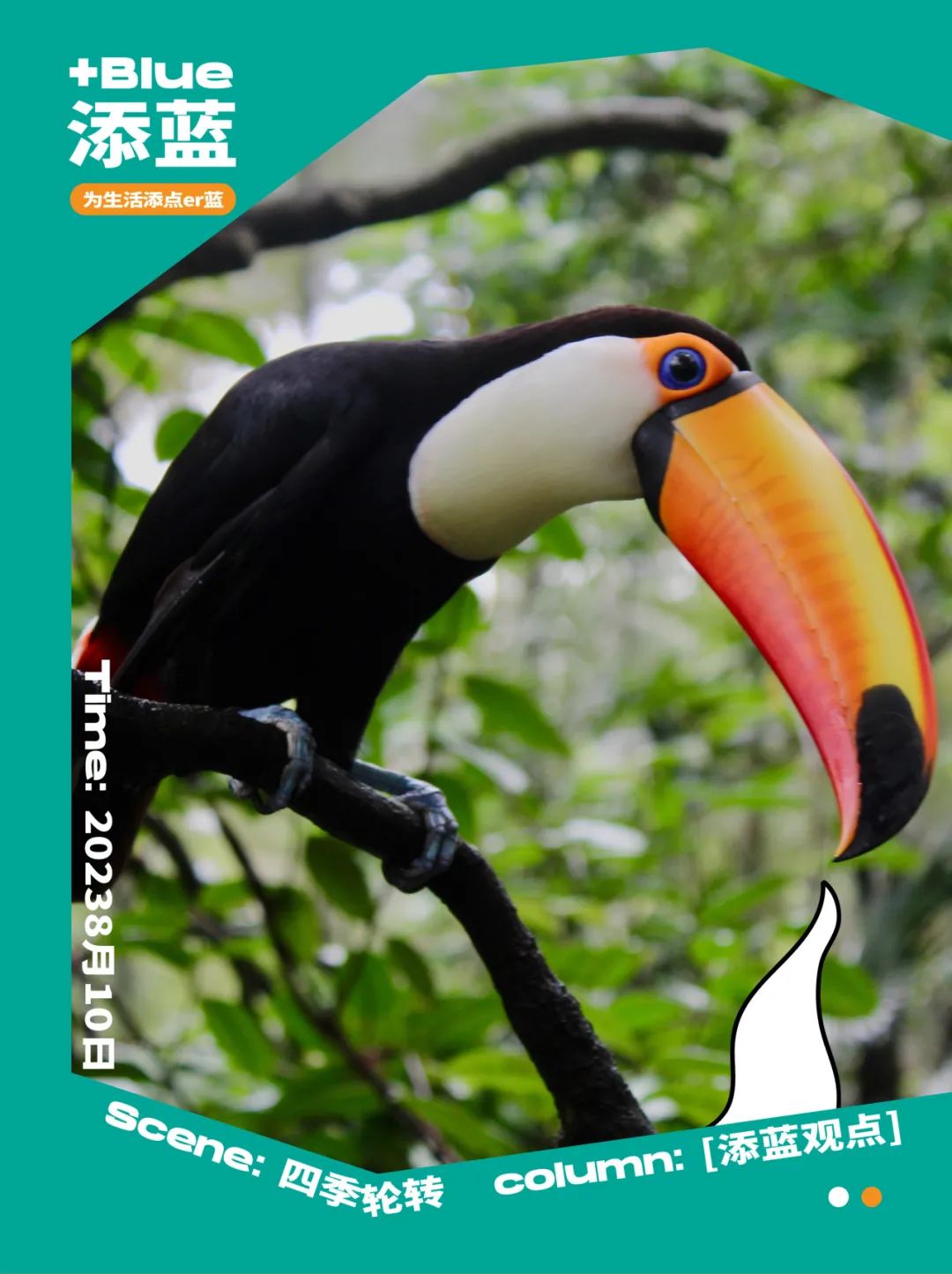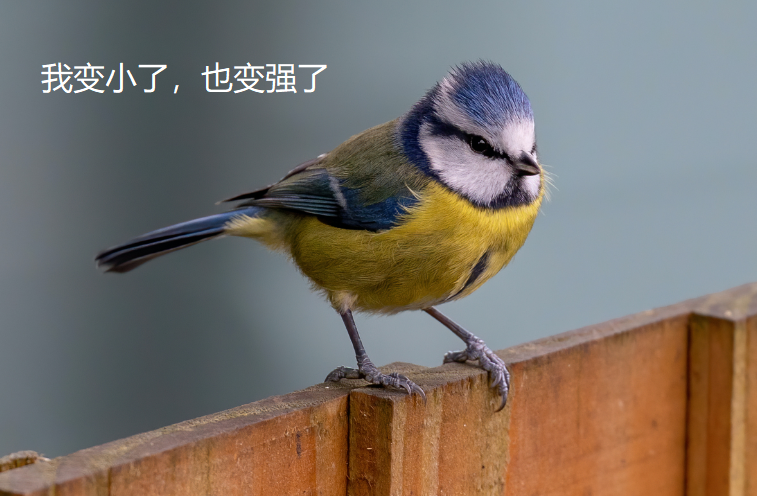
添蓝2023年关注 空气质量与气候变化 的第222天

本周,我们终于迎来了立秋。在刚刚过去的这个夏天,北半球人们不断经历着史上最热一天的洗礼。当7月4日刚刚破了人类有监测记录以来的最高全球平均气温,人们以为自己有幸见证历史的时候,第二天记录再次被打破。然而这还不是终点,更猛烈的酷热在7月6日席卷而来。“至少10万年来”最温暖的记录折磨着北半球的居民,甚至有近百名印度邻居因为高温永远地离开了我们(不要再问我为什么酷热只折磨咱们北半球,因为南半球现在是冬天!)

随着一股股热浪让地球发烫,
人类心里不由得小鹿乱撞,
这高温到底是要闹哪样?
只好冰镇西瓜放手上,
泡着凉水打麻将,
吹着空调吃冰棒,
再跟着DT轻轻唱:
“在我记忆中从来没有这么热的夏天~~~”

● 人类夏日解暑神器—西瓜冰棒。图源/Pixabay

● 人类泡在河水中打麻将。图源/华西都市报

● 俺也一样。图源/2003 Soul Power演唱会

简言之(必看段落):面对高温,动物的身体或某些部位的大小会发生变化。类似于人的嘴唇瞬间遇到极高温度就会变成香肠嘴(不是)。

● 人类嘴唇面对高温后的变化。图源/《东成西就》
详言之(可略过至分割线):1847年,德国生物学家卡尔·伯格曼发现,同一种类的恒温动物,体型会随着生活地区纬度或海拔的增高而变大。因为随着体形的增加,动物体表面积与动物体积之比变小,因而能更好地保存热量。这个理论被称为伯格曼法则。伯格曼法则反映出了动物的体积与温度变化的关系,即温度越低的地方,动物体型越大,温度越高的地方,动物体型越小(Ryding, S. 2021)。
1877年,美国动物学家约耳·阿萨夫·艾伦在此基础上又提出,动物的四肢或其他附属器官的大小也与温度相关:生活在温暖地区的恒温动物,与生活在较为寒冷地区的同类相比,四肢要更大,因为这样更有利于散热。此为艾伦法则。
注:伯格曼法则与艾伦法则,均为法则而非公理,因为其只适用于特定动物,而非在任何情况下都适用。
这两个理论,蓝山雀听了想鼓掌,小鹦鹉听了想增长。
1968-2002年间,英国中心区的年均地表温度增加了1.078℃,使得当地蓝山雀的体重减小了,翅膀的长度则增加了(Yoram Yom-Tov, et al. 2016)。

● 蓝山雀。图源/unsplash
俗话说,嘴上没毛,办事不牢。殊不知嘴上没毛,蓄热也不牢。对于鸟类来说,热交换主要发生在没毛的喙部和腿部。近100年以来,澳洲的平均地表温度提升了0.8℃,而自1871年以来,澳洲的穆加鹦鹉、红冠凤头鹦鹉、红腰鹦鹉的喙部面积分别增加了10.4%, 10%和7%,且和温度的变化呈现了显著的正相关性。(Ryding, S. 2021)

● 穆加鹦鹉(左)红冠凤头鹦鹉(右)。图源/unsplash
还有研究发现,哺乳动物的耳朵、尾巴等突出部位,也会受到气温升高的影响,这些变化可以在猪、鼠、野兔等动物中观察到。(Weaver, M. E., & Ingram, D. L. 1969; Serrat, M. A., King, D., & Lovejoy, C. O. 2008; Williams, C. K., & Moore, R. J. 1989)

● 二师兄让人羡慕的技能之高温中变成大长腿。
图源/Weaver, M. E., & Ingram, D. L. 1969


可爱的动物们强大的适应能力令人类敬佩,但这种适应方式并不是百利而无一害的。比如,过大的喙可能会妨碍进食,肢体越粗壮,生长所需的能量也越多。这可能会影响小可爱们在充满凶险的大自然中觅食和对抗天敌的能力,并没有让其战斗力爆表。
并且,这种“自我改变”也并不是所有动物都能做到的。美国加州旧金山湾区的海湾斑蝶(Euphydryas editha bayensis)就因为气候变化和栖息地丧失带来的降水频率波动,于1987年被美国联邦濒危物种法案列为受威胁物种(McLaughlin J. F., Hellmann J. J., Boggs C. L., et al. 2002)。而自20世纪30年代有记录以来,美国西部大盆地25个鼠兔种群中有7个已经灭绝 (Beever et al. 2003)。


●我是鼠兔。 图源/unsplash
兔兔那么可爱,如果未来的人类无法在现实生活中看到它们,应该会很难过吧。
因此,拥有(空调、西瓜、麻将)爱与善良的人类们,让我们为了守护可爱的鸟类、蝴蝶、兔兔们,以及为了未来可能会受到影响的小可爱们,努力遏制全球气候的持续变暖,让人与自然和谐共生在一个舒适的气候环境中吧。
正所谓:


你还知道高温对小动物们有哪些危害吗?
如何帮助小动物们躲避高温?
请留言告诉我们
撰稿:陆文琦、王思、张伟豪
设计:宁宁、Hara
排版:Ives
参考资料:
The Planet Saw Its Hottest Day on Record This Week. It’s a record that will be broken again and again, https://edition.cnn.com/2023/07/05/world/hottest-day-world-climate-el-nino-intl/index.html, 2023-07-05/2023-07-12
Earth reaches hottest day ever recorded 4 days in a row, https://abcnews.go.com/US/4th-july-breaks-record-highest-temperature-measured/story?id=100702850, 2023-07-07/2023-07-12
Ryding, S. et al. 2021. Shape-shifting: changing animal morphologies as a response to climatic warming. Trends in Ecology and Evolution, VOLUME 36, ISSUE 11, pp.1036–1048
Gardner, J.L. et al. 2011. Declining body size: a third universal response to warming? Trends in Ecology and Evolution. 26, pp. 285–291
Campbell-Tennant, D.J.E. et al. 2015. Climate-related spatial and temporal variation in bill morphology over the past century in Australian parrots. J. Biogeogr. 42, pp. 1163–1175
Yoram Yom-Tov; Shlomith Yom-Tov; Jonathan Wright; Chris J. R. Thorne; Richard Du Feu. 2006. Recent changes in body weight and wing length among some British passerine birds. 112(1), pp. 91–101.
Weaver, M. E., & Ingram, D. L. 1969. Morphological Changes in Swine Associated with Environmental Temperature. Ecology, 50(4), pp. 710–713.
Serrat, M. A., King, D., & Lovejoy, C. O. 2008. Temperature regulates limb length in homeotherms by directly modulating cartilage growth. Proceedings of the National Academy of Sciences, 105(49), pp. 19348–19353.
Williams, C. K., & Moore, R. J. 1989. Phenotypic Adaptation and Natural Selection in the Wild Rabbit, Oryctolagus cuniculus, in Australia. The Journal of Animal Ecology, 58(2), p. 495.
McLaughlin J F, Hellmann J J, Boggs C L, et al. 2002. Climate change hastens population extinctions. PNAS, 99: 6070-6074
Jain, N, 2015. Complex effects of Nitrogen Pollution and Grazing on Nectar resources of the Adult Bay Checkerspot Butterfly (Euphydryas editha bayensis). Master's Theses. 4640. p.10.
BeeverE.A. et al,2003.Patterns of Apparent Extirpation among Isolated Populations of Pikas (Ochotona princeps) in the Great Basin, Journal of Mammalogy, Volume 84, Issue 1,pp.37–54.pp.1036–1048
Gardner, J.L. et al. 2011. Declining body size: a third universal response to warming? Trends in Ecology and Evolution. 26, pp. 285–291
Campbell-Tennant, D.J.E. et al. 2015. Climate-related spatial and temporal variation in bill morphology over the past century in Australian parrots. J. Biogeogr. 42, pp. 1163–1175
Yoram Yom-Tov; Shlomith Yom-Tov; Jonathan Wright; Chris J. R. Thorne; Richard Du Feu. 2006. Recent changes in body weight and wing length among some British passerine birds. 112(1), pp. 91–101.
Weaver, M. E., & Ingram, D. L. 1969. Morphological Changes in Swine Associated with Environmental Temperature. Ecology, 50(4), pp. 710–713.
Serrat, M. A., King, D., & Lovejoy, C. O. 2008. Temperature regulates limb length in homeotherms by directly modulating cartilage growth. Proceedings of the National Academy of Sciences, 105(49), pp. 19348–19353.
Williams, C. K., & Moore, R. J. 1989. Phenotypic Adaptation and Natural Selection in the Wild Rabbit, Oryctolagus cuniculus, in Australia. The Journal of Animal Ecology, 58(2), p. 495.
McLaughlin J F, Hellmann J J, Boggs C L, et al. 2002. Climate change hastens population extinctions. PNAS, 99: 6070-6074
Jain, N, 2015. Complex effects of Nitrogen Pollution and Grazing on Nectar resources of the Adult Bay Checkerspot Butterfly (Euphydryas editha bayensis). Master's Theses. 4640. p.10.
BeeverE.A. et al,2003.Patterns of Apparent Extirpation among Isolated Populations of Pikas (Ochotona princeps) in the Great Basin, Journal of Mammalogy, Volume 84, Issue 1,pp.37–54.
来源: 添蓝


 科普中国公众号
科普中国公众号
 科普中国微博
科普中国微博

 帮助
帮助
 添蓝
添蓝 

